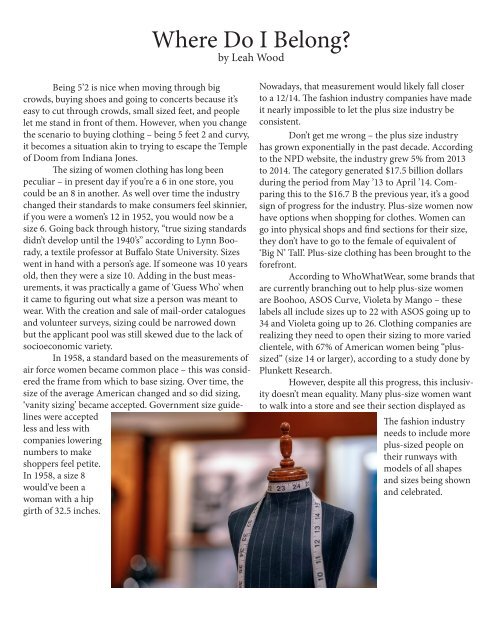RUONCAMPUS MAGAZINE FINAL Version
Create successful ePaper yourself
Turn your PDF publications into a flip-book with our unique Google optimized e-Paper software.
Where Do I Belong?<br />
by Leah Wood<br />
Being 5’2 is nice when moving through big<br />
crowds, buying shoes and going to concerts because it’s<br />
easy to cut through crowds, small sized feet, and people<br />
let me stand in front of them. However, when you change<br />
the scenario to buying clothing – being 5 feet 2 and curvy,<br />
it becomes a situation akin to trying to escape the Temple<br />
of Doom from Indiana Jones.<br />
The sizing of women clothing has long been<br />
peculiar – in present day if you’re a 6 in one store, you<br />
could be an 8 in another. As well over time the industry<br />
changed their standards to make consumers feel skinnier,<br />
if you were a women’s 12 in 1952, you would now be a<br />
size 6. Going back through history, “true sizing standards<br />
didn’t develop until the 1940’s” according to Lynn Boorady,<br />
a textile professor at Buffalo State University. Sizes<br />
went in hand with a person’s age. If someone was 10 years<br />
old, then they were a size 10. Adding in the bust measurements,<br />
it was practically a game of ‘Guess Who’ when<br />
it came to figuring out what size a person was meant to<br />
wear. With the creation and sale of mail-order catalogues<br />
and volunteer surveys, sizing could be narrowed down<br />
but the applicant pool was still skewed due to the lack of<br />
socioeconomic variety.<br />
In 1958, a standard based on the measurements of<br />
air force women became common place – this was considered<br />
the frame from which to base sizing. Over time, the<br />
size of the average American changed and so did sizing,<br />
‘vanity sizing’ became accepted. Government size guidelines<br />
were accepted<br />
less and less with<br />
companies lowering<br />
numbers to make<br />
shoppers feel petite.<br />
In 1958, a size 8<br />
would’ve been a<br />
woman with a hip<br />
girth of 32.5 inches.<br />
Nowadays, that measurement would likely fall closer<br />
to a 12/14. The fashion industry companies have made<br />
it nearly impossible to let the plus size industry be<br />
consistent.<br />
Don’t get me wrong – the plus size industry<br />
has grown exponentially in the past decade. According<br />
to the NPD website, the industry grew 5% from 2013<br />
to 2014. The category generated $17.5 billion dollars<br />
during the period from May ’13 to April ’14. Comparing<br />
this to the $16.7 B the previous year, it’s a good<br />
sign of progress for the industry. Plus-size women now<br />
have options when shopping for clothes. Women can<br />
go into physical shops and find sections for their size,<br />
they don’t have to go to the female of equivalent of<br />
‘Big N’ Tall’. Plus-size clothing has been brought to the<br />
forefront.<br />
According to WhoWhatWear, some brands that<br />
are currently branching out to help plus-size women<br />
are Boohoo, ASOS Curve, Violeta by Mango – these<br />
labels all include sizes up to 22 with ASOS going up to<br />
34 and Violeta going up to 26. Clothing companies are<br />
realizing they need to open their sizing to more varied<br />
clientele, with 67% of American women being “plussized”<br />
(size 14 or larger), according to a study done by<br />
Plunkett Research.<br />
However, despite all this progress, this inclusivity<br />
doesn’t mean equality. Many plus-size women want<br />
to walk into a store and see their section displayed as<br />
prominently as other sections. The fashion industry<br />
needs to include more<br />
plus-sized people on<br />
their runways with<br />
models of all shapes<br />
and sizes being shown<br />
and celebrated.


